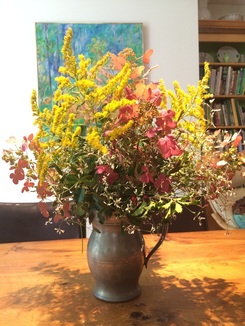
Before I gardened I spent a fortune at florists buying flowers. At my most penurious flowers uplifted my soul and I would make sure my friday route home included a stop at a Boston flower market so I could fill my apartment with flowers that over the weekend. I was always rubbish at arranging them, more English freestyle than an orchestrated arrangement. Decades later that style still seems an appropriate match for my rather untidy home.
My garden is in transition now, leaves are beginning to yellow and shrivel, seed heads are becoming more prominent among the flowers. There is an earthy smell in the morning, the scent of decomposing leaves and earth and you can see, hear and smell that summer is waning.
As the bee-balm and phlox succumb to the inevitable mildew, asters, salvias and turning leaves are coming into their own, and the annuals are putting out their final hurrah and calling out to be gathered in.
Flowers of all types are best picked early in the morning when their stems are turgid or full of water. If you don't manage to pic first thing it's best to wait until early evening when they've had a chance to recover from the heat of the day and are less water-stressed. If possible, it's great to carry a bucket of water with you and plunge the stems into it as soon as they've been cut. The great thing about annuals (and some perennials) is that they will actually bloom much longer if picked regularly which is a great justification for filling your house with vases of fresh flowers.
I'm slightly slip-shod about conditioning flowers to prolong their bloom but their are certain rules that are easy to follow and really help. All foliage that will be below the water level should be cut off so it doesn't rot. Try and cut stems cleanly at an angle with sharp secateurs or garden scissors so their stems are not crushed and they can take up water effectively. Also try to re-cut the tens before arranging them and if there is time place them in a bucket of cold water and leave in a cool place for a few hours or overnight before bringing them into a warm room.
It's best to always use clean vases and add some cut-flower food to the water before adding the flowers - this helps not only to feed the flowers but keep the water clean as it also contains an anti-bacterial treatment. I usually don't have purchased cut flower food in the house, a home-made preservative is not as effective but simple and cheap to make and better than nothing. Just add a tablespoon of vinegar, a teaspoon of sugar and 3-5 drops of bleach to 4 cups of water and stir well.
Once you've arranged the flowers, check the water level every few days and top up as necessary. It's best to change the water at least every 4 days and re-cut a tiny smidgen off each stem when you do so. Removing dead or dying flowers and adding some new keeps the arrangement looking fresh for much longer.
 RSS Feed
RSS Feed
